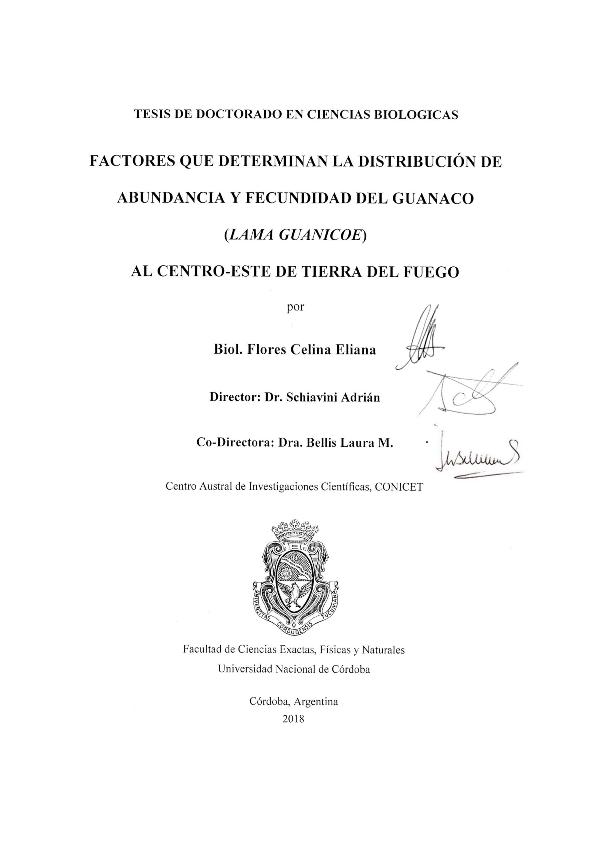Tesis doctoral
La distribución de las especies en el espacio geográfico, así como su abundancia, responden al arreglo de las condiciones habitables del paisaje. En grandes herbívoros, los factores tanto “interactivos” como “no interactivos” determinan sus patrones de distribución, aunque dependiendo de la escala de análisis. Los factores “interactivos”, a diferencia de los factores “no interactivos”, son aquellos que afectan la aptitud de la especie, y que pueden ser modificados por ella. El objetivo de esta tesis fue evaluar, a escala intermedia, la influencia de factores “interactivos” y “no interactivos” en la distribución espacio-temporal de abundancia y fecundidad del guanaco (Lama guanicoe) al centro-este de Tierra del Fuego, mediante modelado de la superficie de densidad. La escala se definió como intermedia, dado que el tamaño del “grano” y la “extensión” del estudio están comprendidos entre el área de acción y el rango de distribución de la especie. También se evaluó la calidad forrajera de las gramíneas de las unidades fisonómicas del pastizal (Pradera, Estepa Graminosa y Estepa Subarbustiva). La distribución de abundancia y de fecundidad, resultaron influidas por factores tanto “interactivos”, como “no interactivos”. Acorde a la variación de la abundancia en función de los factores físicos y de disponibilidad de forraje, se identificó un patrón de distribución general, con mayor cantidad de individuos en las zonas bajas, donde domina la Estepa Graminosa. Según la variación de la fecundidad en función de los factores de distribución por riesgo de caza y de disponibilidad de forraje, se identificó un patrón de distribución general, con mayor cantidad de chulengos por grupo familiar cerca de la infraestructura humana, donde domina la Estepa Graminosa o donde disminuye el Índice de Vegetación Normalizado más frecuente. Puesto que en la época reproductiva, la Estepa Graminosa y los sitios con valores bajos del Índice de Vegetación Normalizado más frecuente presentan disponibilidad de forraje intermedia a baja, el guanaco ocupó las zonas con menor oferta de alimento. Esto respondería a la interacción competitiva con ganado y al riesgo de predación, considerando que la abundancia y la fecundidad del guanaco se incrementaron con la disminución de la carga de ganado, de la distancia a la infraestructura humana y en las zonas bajas. Las zonas bajas y próximas a la infraestructura humana se asociarían a un menor riesgo de predación, porque favorecen el escape de predadores y son evitadas por estos. Futuros estudios que evalúen, en qué medida el guanaco satisface sus requerimientos nutricionales, y en qué medida es afectado por la predación y la ganadería, son indispensables para valorar el estado de conservación de la especie. The geographical distribution of species, as their abundance, responds to the arrangement of the habitat condition. In large herbivores, the “interactive” as the “noninteractive” factors determine their distribution pattern. Thought it also depends on the scale analysis. The objective is to evaluate, in a intermediate scale, the influence of the “interactive” and “non-interactive” factors in the space-time distribution of abundance and fecundity of the guanaco (Lama guanicoe) in the center-east part of Tierra del Fuego by means of surface density modelling. The scale was defined as “intermediate”, given that the size of the “grain” and the “extension” of the study are conceived between the area of action and the distribution space of the species. We also evaluate the quality of the forgeable grasses of the physiognomic units in the pastureland (meadow, tussock grasslands and shrubby grasslands). The distribution of abundance and fecundity resulted influenced by “interactive” as “non-interactive” factors. According to the variation in the abundance as a function of the physical factors as the forage availability, we identified a general distribution pattern, with more specimens on the low zones, where the tussock grassland dominates. In relation to the variation in the fecundity as a function of the hunting distribution factors and the forage availability, we found a general distribution pattern, with higher amounts of “chulengos” by family group near human buildings, where the tussock grassland dominates or where the Normalized Vegetation Index decreases more frequently. Given that in the breeding season, the tussock grassland as the sites with the lower Normalized Vegetation Index present intermediate to low forage availability, the guanaco occupied the sites with the least food supply. This could answer to the competitive interaction with the livestock and to the predation risk, considering that the abundance and fecundity of the guanaco were increased as the livestock load decreased, to the distance of the human infrastructure and at the low zones. The lower and near human infrastructure zones could be associated with lower predation risk, as they favor the escape and are avoided by predators. Future studies that assess to what extent the guanaco satisfies its nutritional requirements, and how much is it affected by predation and/or livestock, are indispensable to value the conservative state of the specie.
Factores que determinan la distribución de abundancia y fecundidad del guanaco (Lama guanicoe) al centro-este de Tierra del Fuego
Flores, Celina Eliana

Director:
Schiavini, Adrian Carlos Miguel

Codirector:
Bellis, Laura Marisa

Fecha de publicación:
21/03/2018
Idioma:
Español
Clasificación temática:
Resumen
Palabras clave:
Guanaco
,
Distribución
,
Abundancia y fecundidad
,
Calidad Forrajera
Archivos asociados
Licencia
Identificadores
Colecciones
Tesis(CADIC)
Tesis de CENTRO AUSTRAL DE INVESTIGACIONES CIENTIFICAS
Tesis de CENTRO AUSTRAL DE INVESTIGACIONES CIENTIFICAS
Citación
Flores, Celina Eliana; Schiavini, Adrian Carlos Miguel; Bellis, Laura Marisa; Factores que determinan la distribución de abundancia y fecundidad del guanaco (Lama guanicoe) al centro-este de Tierra del Fuego; 21-3-2018
Compartir



